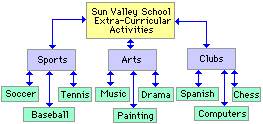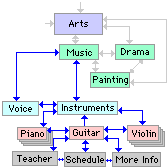-
Web page design: types of navigation
普通类 -
- 支持
- 批判
- 提问
- 解释
- 补充
- 删除
-
-
Introduction
THE MAIN GOAL OF A USER-FRIENDLY NAVIGATION SYSTEM is to prevent users from getting lost. Navigation design means creating interfaces that help people understand where they are, where they can go and how to get there. A good navigation design will create short and simple paths between elements, minimize travel steps by creating hierarchies with the fewest possible levels, and minimize redundancy by creating only the necessary paths (Kristof & Satran, 1995). To design an efficient site, it is necessary to understand the types of navigation systems and how they relate to each other.
.jpg)
-
Hierarchical Navigation
Navigation throughout a web site simply means going from one place to another by clicking on elements that operate as links. Those elements can be words or phrases embedded in the text, graphics such as drawings or pictures, and even different types of animations. When you click on a link, you can access additional information that can be contained in the same page, another page within the same site, or in a completely different site. The main navigation is defined by the hierarchy of the information.Once the structure of the information is established, the conceptual relationship between the structural elements constitute the navigation. The options to go from the home page to other pages respond directly to the information hierarchy.
A hierarchical navigational mechanism helps in organizing information and mirrors the content's structure.-
Site-wide Navigation
In some instances you might need to access information within a site that does not follow the information structure. A site-wide navigational system enables greater flexibility of lateral and vertical movement throughout an entire site. This system complements the information hierarchy when it is necessary to give users additional options to navigate bypassing the hierarchy. For instance,this system may provide links on second or third level pages to go back to the home page and to a discussion forum. Those links wouldn't be necessary on the first level or home page where they would be redundant. A more complex site-wide navigation system may provide links to lower level pages which contain site-specific information.
A site-wide navigational scheme improves flexibility by enabling lateral and vertical movement within a site.-
Local Navigation

The need to implement a local navigation system may stem from the need to provide a unique navigational scheme to a collection of web pages that belong to a large site. This navigation system operates only within those pages. For instance, a products' catalog embedded in a company's site may require a complimentary system of navigation specific to the catalog's pages. The catalog's pages also require a site-wide navigation mechanism to allow users to go to the company's home page as well as to leave the site.-
More Info
Navigation Systems within a Site
Designing Navigation Systems
Navigating the Information Architecture Maze
Related Articles
Web Page Design: GIF vs. JPEG
Web Page Design: Layout Control
Web Page Design: Graphic Resources for Non-Artists-
Author
Vera Pienknagura
Graduate Student
Department of Educational Technology
San Diego State University -
-
- 标签:
- types
- navigation
- site
- pages
- navigational
- web
- design
- elements
- information
- page
- site-wide
-
加入的知识群:



学习元评论 (0条)
聪明如你,不妨在这 发表你的看法与心得 ~